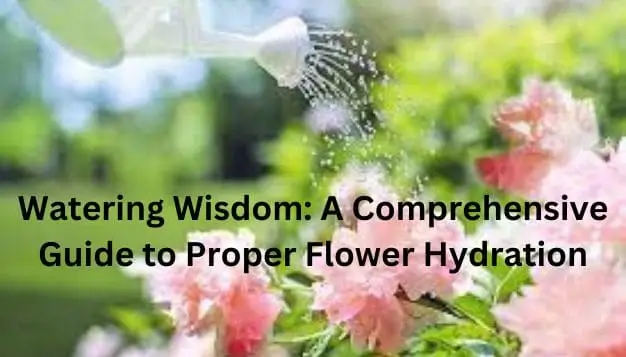Watering your flowers may seem like a straightforward task, but there’s more to it than meets the eye. Achieving the perfect balance of hydration is crucial for the health and vitality of your plants.
Keeping flowers properly hydrated is an essential part of caring for cut flowers or potted plants. Understanding the water needs of different types of flowers will help ensure they stay healthy, vibrant, and long-lasting.
In this guide, we delve into the intricacies of proper flower hydration, offering valuable insights, tips, and techniques to help you become a master of the watering can.
Understanding the Basics
Before we dive into the specifics, it’s essential to understand the fundamental factors that influence flower hydration. Soil type, climate, plant species, and individual plant needs all play a role in determining how much water your flowers require. Developing watering wisdom begins with observing and understanding these variables.
- Know Your Soil: Different soil types have varying water retention capacities. Sandy soils drain quickly, while clayey soils can hold onto moisture for an extended period. Understanding your soil’s characteristics helps tailor your watering routine to suit your specific garden conditions.
- Consider the Climate: Your local climate heavily influences your plants’ water needs. Hot and dry climates demand more frequent watering, while cooler climates may require less. Be mindful of seasonal changes and adjust your watering schedule accordingly.
- Plant-Specific Requirements: Each plant species has its unique water requirements. Some plants prefer consistently moist soil, while others thrive in drier conditions. Research the specific needs of your flowers to provide the best care possible.
The Art of Proper Watering
Now that you’ve grasped the basics, let’s explore the art of proper watering to ensure your flowers flourish.
- Timing is Key: Water your plants early in the morning or late in the afternoon when temperatures are cooler. This minimizes water loss due to evaporation and allows plants to absorb moisture more efficiently.
- Deep Watering vs. Surface Watering: Deep watering encourages plants to develop deep root systems, making them more resilient to drought. Focus on delivering water to the root zone rather than just moistening the soil surface.
- Consistency Matters: Establish a consistent watering schedule to provide stability for your plants. Avoid sporadic watering, as it can lead to stress and negatively impact flower health.
- Mulching Magic: Mulching around your flowers helps retain soil moisture, suppresses weeds, and moderates soil temperature. Organic mulches like straw or wood chips are excellent choices.
- Container Gardening Considerations: Container plants often require more frequent watering than those in the ground. Ensure proper drainage in containers and monitor moisture levels closely to prevent waterlogged soil.
Signs of Overwatering and Underwatering
Recognizing signs of overwatering and underwatering is crucial for adjusting your watering regimen promptly.
- Overwatering Signs:
- Yellowing leaves
- Wilting despite moist soil
- Root rot
- Fungus or mold growth on the soil surface
- Underwatering Signs:
- Dry, brittle leaves
- Leaf drop
- Stunted growth
- Soil pulling away from the container edges
Advanced Techniques for Watering Wisdom
For those seeking to elevate their gardening prowess, consider these advanced techniques:
- Drip Irrigation Systems: Install a drip irrigation system to deliver water directly to the root zone, promoting efficient water use and reducing the risk of foliage diseases.
- Rainwater Harvesting: Collecting rainwater not only conserves water but also provides plants with natural nutrients. Set up a rain barrel to harness this eco-friendly water source.
- Hydrogel Applications: Hydrogels, water-absorbing polymers, can be mixed into the soil to enhance water retention, especially in sandy or fast-draining soils.
Conclusion
Mastering the art of proper flower hydration is a journey that involves observation, adaptation, and a touch of finesse. By understanding the unique needs of your plants, recognizing signs of overwatering and underwatering, and implementing advanced watering techniques, you’ll cultivate a garden that blooms with vitality and beauty. Watering wisdom is not just about quenching your flowers’ thirst; it’s about nurturing a thriving ecosystem that brings joy and harmony to your outdoor space.

